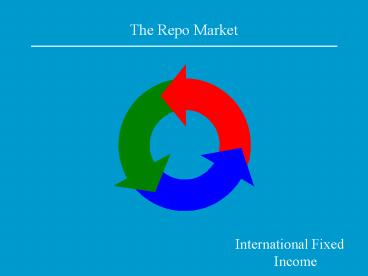The Repo Market - PowerPoint PPT Presentation
1 / 18
Title:
The Repo Market
Description:
The Repo Market. International Fixed Income. Readings. Repo's gone global and hip ... Illustration ... Illustration continued... – PowerPoint PPT presentation
Number of Views:248
Avg rating:3.0/5.0
Title: The Repo Market
1
The Repo Market
- International Fixed Income
2
Readings
- Repos gone global and hip
- Innovation is the key
- Merrill Lynch guide to international repo
3
Overview of this Lecture
- Agenda
- I. Repo basics
- II. Features of the repo market
4
Section IRepo Basics
5
Repurchase Agreements
- Repurchase agreement (repo) a contract to sell a
security and then repurchase it at a later date
for a specified price. - We can think of a repo as a collateralized loan,
where the collateral is the security. This is
because the seller of the security retains the
right to receive any interest paid on the
security over the term of the repo agreement. - Repos are one of the largest sectors of the money
market (approximately 1 trillion daily). - The repo market provides attractive returns to
money market investors, and an inexpensive source
of financing for security holders.
6
Illustration
- A government securities dealer buys 25 million
worth of the 6¾ T-notes of 8/15/2005 to hold
overnight. - Where does the dealer get the funds to finance
his position? - The dealer could use his own funds, borrow from a
bank, etc... - But the repo market is typically the cheapest
source of financing. - So, lets assume the dealer uses the T-notes as
collateral and enters into a repo.
7
Illustration continued...
- A customer of the dealer (e.g., some municipality
with newly collected tax receipts) has 25
million it would like to invest overnight. - The dealer sells the customer the T-notes for
settlement today, and agrees to buy them back
tomorrow for 25 million plus interest. - The interest rate is called the repo rate.
- If the repo rate is 5½, then the total interest
paid is (5½)(1/360)25 million 3819.44.
6
8
Illustration continued...
- The customer has, therefore, invested 25 million
overnight at a 5½ rate. - Credit risk aside, the customer does not care
whether the price of the 6¾ T-notes goes up or
down. - The market risk is assumed by the dealer.
9
A Reverse Repo
- Now, suppose its the customer who owns 25
million worth of the 6¼ T-notes of 8/15/2005 and
wants to borrow funds overnight. - The dealer buys the T-notes for settlement today,
and simultaneously agrees to sell them back to
the customer tomorrow for 25 million plus
interest in the amount of (5¾)(1/360)25 million
3993.06. - The result is that the customer has borrowed 25
million overnight at 5¾.
10
Repo and Reverse Repo Jargon
- Repo (Dealer)
- Selling collateral
- Borrowing money
- Reversing out securities
- to repo securities
- Reverse Repo (Dealer)
- Buying collateral
- Lending money
- Reversing in securities
- to do repo
Obviously, it is important to recognize that the
dealer's repo is, from the standpoint of the
customer, a reverse repo. We will always refer
to the transaction from the dealers perspective.
11
A Repo Graphically
Borrower (buyer) of collateral
Borrower of money
(that is)
(that is)
Supplier (seller) of collateral
Lender of money
12
The Government Repo Market
13
Section IIFeatures of the Repo Market
14
Dealers
- Dealers enter into repos for a variety of reasons
- Inventory most dealers and traders do not own
all the securities in their inventory outright,
so the standard practice is to finance holdings
by borrowing in the repo market. - Short positions dealers also use the repo market
to cover short positions (i.e., they buy the
securities to cover the short position and sell
them back in a reverse repo). - Matched books dealers buy collateral from one
customer (e.g., a thrift) and sell to another
(e.g., a money market fund) at lower rate.
15
Terms of the Loan
- Overnight repos one-day transactions
- Approximately 50 of the market.
- Open repo is an overnight repo that rolls over
automatically. - Term repos transactions beyond one-day (up to
one year). - Vast majority of repos have maturities of three
months or less.
16
Credit Risk
- Both parties are subject to credit risk
- The market value of the collateral can change,
and one or both party's overall financial
position may change for a variety of other
reasons.
17
Illustration
- Suppose a school district enters into a 10
million 30-day repo with a dealer who is
under-capitalized. - The dealer delivers the 10 million in T-notes,
but is forced into bankruptcy and cannot
repurchase them. - The school district can sell the collateral in
the open market to get its money back. However,
if the market price of the T-notes has fallen,
then the district will suffer a loss.
18
Ways to Reduce Credit Risk
- Margin
- Lenders often require margin to limit their
credit exposure (typically 1 to 3). - Example a customer enters a repo for 10 million
with a 2 margin. The dealer delivers 10.2
million worth of securities, receives 10
million, and repurchases the securities on a
future date for 10 million plus interest. - Marking to market
- Collateral is valued at current market levels and
the trade is adjusted through a marginal call
(dealer sends more collateral) or repricing
(funds are delivered to customer).































